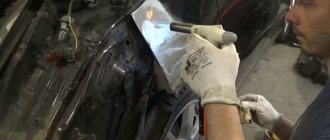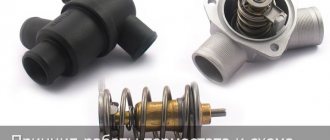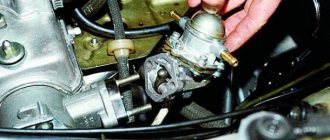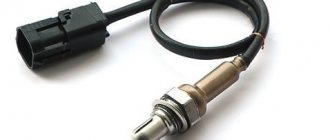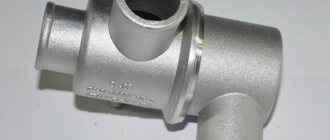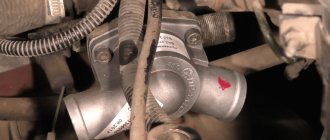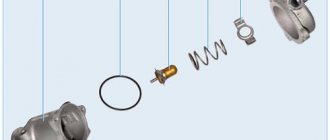In 80% of cases, checking the thermostat is easy to do without removing it from the car. The two “on-site” diagnostic methods described in the article make it possible to identify 5 out of 5 possible malfunctions of this part. Disassembling the cooling system will only be required to clarify or confirm the diagnosis, as well as to replace the thermostat in case of confirmed inoperability.
Operating principle and functions of the thermostat
In order to confidently use the thermostat diagnostic methods proposed in the article, you will have to understand a few things. Namely:
- How does a thermostat work?
- Why is it needed at all?
- How does it perform its functions in good condition?
The thermostat works extremely simply. It is a valve that opens or closes when the coolant reaches certain temperatures. When the antifreeze is cold, the thermostat is closed. At temperatures above 80 °C (depending on the engine) - opens. This works due to the fact that inside the part there is a special capsule containing a mixture (wax based) that strongly expands when heated. When it heats up, its volume increases, the capsule presses on the rod and, overcoming the resistance of the spring, opens the valve.
Now let’s look briefly at why a thermostat is needed and what functions are assigned to it. To do this, consider the design of a car engine cooling system in a simplified form. And it consists of two circuits:
- Small circuit - includes the “water jacket” of the engine, as well as the radiator, which is used to operate the heater inside the car.
- Large circuit - includes all of the above, plus the main radiator and expansion tank.
The thermostat is installed in the system in such a way as to separate or communicate these two circuits at the right time. When the engine is still cold or has only reached normal operating temperature, the valve is completely closed. The coolant circulates only in a small circuit. Due to this, the engine warms up faster. In addition, you can turn on the heater earlier to heat the car interior in winter.
When the coolant temperature reaches a critically high temperature, the thermostat begins to open slightly according to the principle described above. Part of the hot antifreeze enters the main radiator, where it is cooled. Meanwhile, cold (or chilled) liquid flows into the small circuit. When the temperature in the small circuit decreases, the thermostat closes. Due to this, the nominal operating temperature of the engine is constantly maintained.
It should be noted that the thermostat valve does not necessarily open or close completely. It operates as the coolant temperature increases or decreases, and changes its throughput accordingly. This feature allows for smoother thermoregulation, due to which there are no sudden temperature changes in the system.
Let's sum up the intermediate results. A thermostat is needed in order to:
- a cold engine reaches operating temperature faster;
- Previously, it was possible to use the stove in the cabin;
- the coolant temperature was maintained at the required level;
- in case of overheating, lower the temperature in the small circuit by dumping some of the antifreeze into the main radiator for cooling.
That is, if there were no thermostat, the engine would take a long time to warm up, and in winter it would not reach operating temperature at all. To eliminate this problem, the volume of the cooling system would have to be reduced. But in this case, the engine will quickly overheat and boil. This is important to understand because part of the diagnosis described below is based on it.
Device
Modern thermostats come in several types. The design depends on the volume of coolant in the system and the total pressure created by the water pump. 3 main designs:
- The simplest regulator with a non-separable brass body. It has only 3 pipes, as it is intended for small engines. Often installed on classic VAZ cars.
- A more advanced thermostat with a collapsible housing. Has more than 3 bends for connecting pipes.
- Similar to the previously described, but two-valve thermostat. Has 2 working locking mechanisms. It works on the principle of a single-valve regulator, but each valve closes a separate circulation circle.
Regardless of the model, the standard mechanism of this part consists of:
- Cylindrical, less often square, body made of brass, copper or aluminum.
- The body is equipped with tubular bends for attaching main rubber pipes.
- The main shutter valve, it is this that regulates the width of antifreeze circulation.
- The spring creates the necessary pressure on the valve when it is closed and returns it to the seat after opening.
- A special thermocouple consisting of a tube with a certain amount of wax inside.
- The rod contains all the components of the thermostat.
There are electronic thermostats that are similar in design, but are supplemented by a heating element and a power supply connector.
Thermostat malfunctions and their symptoms
Many car enthusiasts follow a path that seems simpler to them - they start looking for faults, not knowing what they might be. However, a car is a mechanism in which no matter what part you take, you will encounter a whole range of breakdowns. There is a similar problem with the thermostat. It has not just one malfunction, but five. It is proposed to begin diagnostics by studying them. Along the way, we will consider the consequences that should be expected in the event of a particular thermostat failure.
Fault 1. Thermostat is stuck open
As practice shows, valve jamming in the open position is the most common malfunction. It occurs for various reasons, all of which have the same outcome. Namely, the thermostat is constantly open, regardless of the coolant temperature. This means that antifreeze is always circulating in a large circuit.
As a result of the thermostat being stuck open, the following problems arise:
- the engine takes a long time to warm up in summer;
- in winter it doesn’t even reach operating temperature;
- the stove blows either slightly warm or completely cold air;
- the engine is unstable and not at full power;
- fuel consumption increases significantly;
- the lubricating properties and fluidity of engine oil are reduced;
- as a result, the wear of rubbing engine parts accelerates.
As a rule, car enthusiasts pay attention to this breakdown precisely in the winter season, when a stove is needed, but it does not heat. Although in fact, the cold in the cabin is not the most unpleasant consequence of this thermostat malfunction. Accelerated engine wear and increased fuel consumption are much more serious problems.
Fault 2. Thermostat is stuck in the closed position
This breakdown is less common than the first, but it is much more dangerous. When the thermostat valve is stuck in the closed position, coolant can only circulate through a small circuit, and access to the main radiator is cut off. As a result, the engine and stove normally reach operating temperature, but soon the antifreeze overheats and boils. Very high pressure is created in the system, and it eventually ruptures at its weakest point.
Unlike the first malfunction described, it will not be possible to operate a car for a long time with the thermostat stuck in the closed position. As soon as this happens, the engine will quickly reach operating temperature upon first start-up, and will immediately begin to overheat. If you do not pay attention to the coolant temperature gauge in a timely manner, then within a few minutes thick white steam will pour out from under the hood. It is possible that the engine will overheat to such an extent that the piston mechanism parts will jam, and then there will be even more problems.
The thermostat jamming in the closed position most often occurs for the same reason - the expanding composition flows out of the capsule, and the valve can no longer overcome the resistance of the spring. The valve disc may also become stuck in the thermostat housing. This happens after a very long period of inactivity of the car, but does not occur during regular use.
Fault 3: Thermostat opens and closes early
If the thermostat opens too early, coolant from the small circuit is dumped into the main radiator before reaching normal operating temperature. As a result, the engine never warms up completely. Accordingly, the defect is accompanied by poor operation of the stove, slightly increased fuel consumption, decreased throttle response and other problems described when considering the first malfunction.
Fortunately, this breakdown is very rare. Basically, when a non-original thermostat is installed in the cooling system the day before. The fact is that different engines have different optimal operating temperatures, and thermostats are developed in accordance with these indicators. As a result, if you put a non-original part on the car, the valve may open and close too early.
Fault 4. Thermostat opens and closes late
These defects are similar to the previous ones, but are more dangerous. If a thermostat that opens and closes early is simply an unheated engine, then if it operates late, the coolant may boil and destroy the system. The main radiator fan in this case, again, will not help in any way, since the hot liquid reaches the sensor that turns on the airflow late.
The manifestation of these malfunctions occurs for the same reason as in the previous case. The installed thermostat is designed to operate at other temperatures. However, one should not discount the possibility that the timing of the valve opening and closing has shifted due to wear. For example, if over time the spring that returns and holds the thermostat in the closed position weakens, then it will begin to open earlier than it should.
Malfunction 5. The thermostat does not open or close completely
The last common thermostat failure is when its valve, for one reason or another, cannot open or close completely. This malfunction is not as critical or dangerous as jamming in the closed position. But still, some unpleasant consequences will appear.
So, if the thermostat does not close completely, the large circuit is not completely cut off from the small circuit when the engine is cold or trying to reach operating temperature. Even such a seemingly insignificant defect is enough for the engine to warm up for a long time, and in winter it never reaches normal temperature. Again, the stove does not heat well, more fuel is consumed, the engine oil does not reach the required fluidity, and so on.
The second option, when the valve does not open completely, can be much more dangerous. The problem lies in the fact that under heavy load, the thermostat’s throughput is not enough to dump the overheated antifreeze into the radiator in the required volume for cooling. The result can be as sad as described in the case of the valve jamming in the closed position.
Closed position
This malfunction occurs most often. The reasons for such a problem may lie in the nuances of operating the machine. The thermostat does not open if:
- Too much scale, dirt, and oxidation have accumulated in its mechanism. The reason may be the use of ordinary tap water instead of antifreeze. Many people dilute antifreeze with distilled water, which also leads to scale formation in the system.
- Inappropriate antifreeze has been selected for the cooling system. Coolants are divided according to the degree and temperature of heating. If the thermostat response threshold is many times lower than the boiling point of the antifreeze, the opening time of the regulator will increase, which will lead to overheating.
- The return spring breaks or loses tension. The cause may be the device itself if it is not manufactured to the required standards. Often new regulators from unscrupulous manufacturers suffer from this problem. The spring may wear out from using water for cooling. Water oxidizes and reduces the life of the metal.
- The thermostat does not open due to a broken valve cup mounting. The reasons are similar to a broken spring.
- Failure of the thermoelement. This part becomes unusable due to breakdown or deformation of the tube in which the wax is enclosed. This element is very sensitive, since its work is based on the pressure created during expansion from heating.
- Electronic thermostats suffer from the problem of complete jamming due to a faulty thermistor, oxidation of the power connector contacts, or an open circuit. Often the cause may be a temperature sensor that is unable to determine the current system temperature.
All these features must be taken into account in the process of selection and further operation of this unit.
Checking the thermostat in three easy ways
As promised at the very beginning, two of the three proposed methods for diagnosing a thermostat allow you to identify faults without removing the part from the machine. The latter method will require partial disassembly of the cooling system, but, on the other hand, it is more accurate and visual.
Method 1: Checking the thermostat on the dashboard
The cooling system of any car has an antifreeze temperature sensor. It is always installed on a small circuit, that is, conditionally in front of the thermostat. This sensor is connected to the temperature indicator, which is located on the dashboard. Its role can be either a regular arrow with a scale or a digital display. Regardless of the design, a pattern is observed in the operation of the temperature indicator, by the violation of which it is possible to determine malfunctions of the thermostat.
And the indicator works as follows when the thermostat is working. When a cold engine is started to warm up, the temperature rises noticeably within a few minutes. Then the arrow (or numbers) stops at a certain mark, and remains in approximately the same position for some time. If you then give the engine a normal load (start moving), then over time you will notice how the pointer drops sharply and then smoothly begins to rise. Then the cycle is repeated, and the intensity of changes in temperature readings varies depending on the load on the engine and a number of other factors (outdoor temperature, driving speed, engine features, stove operating mode, etc.).
Now let's look at several situations that indicate a thermostat failure:
- The engine temperature (arrow or numbers) does not rise for a long time or does not reach the norm - this clearly indicates that the thermostat is stuck in the open position, or it is not fully closed.
- The engine warms up a little (judging by the arrow), but never reaches operating temperature - the same thing. The thermostat is constantly in the open or slightly open position.
- The engine is overheating, as indicated by the coolant temperature arrow going off scale - the thermostat is stuck in the closed position, or it does not open completely.
Please note that the third of the described situations does not always indicate a thermostat failure. The engine can also boil due to the fault of the radiator or the fan blowing through it. That is, the thermostat may have worked, but the antifreeze in the radiator does not cool as it should. This often happens if, for example, the honeycombs in the radiator are clogged with dirt or insects, or if the fan breaks down.
Method 2. Checking the thermostat based on coolant temperature
To check the thermostat using this method, it is better to use some tool that allows you to measure temperatures within 100 °C. A multimeter with a temperature sensor is suitable for this purpose. Alternatively, you can steal a cooking thermometer from the kitchen. It’s even better if there are two such devices.
The thermostat is checked using the following simple algorithm (for two thermometers):
- The sensor of the first thermometer is fixed to the pipe leading from the thermostat to the main radiator. This can be done using electrical tape or stationery tape. The main task is to attach the sensor to the pipe as tightly as possible, and also close it so that the ambient temperature does not introduce errors.
- The second thermometer must be fixed somewhere on a small circuit, and as close as possible to the thermostat. If you don’t find another extra tool, you can do without it.
- The engine should initially be cold. In addition, fiddling with thermometers when the engine is hot is quite dangerous. There is a high risk of getting burns.
- We start the engine and monitor the coolant temperatures before and after the thermostat using the installed thermometers.
- Knowing now how the thermostat works, we can draw appropriate conclusions based on the temperature readings obtained.
For example, if during the process of warming up the engine the temperature on both sides of the thermostat increases approximately equally, the valve is clearly stuck in the open position. The norm should be considered a situation where the coolant in a small circuit quickly warms up, but in a large circuit it remains cold for the first time, or warms up with a significant lag.
Here, it is probably worth clarifying a little some of the features of the thermostat design. The fact is that on many cars the valve, even in the fully closed position, is not completely sealed. There is a small hole in it, which is necessary to relieve excess pressure that arises in the small circuit as the engine warms up. The exception is those cooling systems in which a separate valve is provided in the small circuit to relieve excess pressure.
Accordingly, if the temperature up to the thermostat continues to rise endlessly, and on the way to the radiator the pipe is cold or barely warm, then there is a possibility that the valve is stuck in the closed position. Or it opens very late. To find out this using thermometers, you will need to first find out at what temperatures the thermostat on a particular motor should start to operate.
As practice shows, this method of checking the thermostat is more preferable and accurate than the first. And all because on many not new cars, the cooling system parts are replaced with non-original ones. For example, temperature sensors are often installed, due to which the arrow on the dashboard begins to “lie.” Accordingly, focusing on it is almost pointless. But directly measuring the coolant temperature using third-party devices eliminates such errors.
Method 3. Checking the thermostat in boiling water
The last method of checking the thermostat requires partial disassembly of the cooling system, however, it allows you to personally verify its serviceability, timely operation or any breakdown. In some cases, after dismantling it is clear that the part has one of the defects described above, and the subsequent steps are no longer necessary.
The algorithm for checking the thermostat using this method is as follows:
- Drain 1-2 liters of antifreeze from the cooling system. This will prevent you from spilling it during further actions. There is absolutely no need to completely drain the system. Unless along the way you decide to replace the old antifreeze with fresh one.
- According to the instruction manual, remove the thermostat from the housing.
- Visually inspect the thermostat. It must be completely closed. If the valve plate is slightly open or “frozen” in the fully open position, then the test does not need to be continued.
- Take a small container of water.
- Immerse the thermostat in water so that it does not touch the bottom (you can hang it on a wire).
- Similarly, immerse a thermometer in water to measure the water temperature with a scale of at least 120 °C. The thermometer should also not touch the bottom of the vessel, since the temperature there will be higher than in the water itself.
- Heat the container on a gas stove or other available method. It is highly undesirable to use an electric immersion boiler for this procedure. It heats the water in the pan unevenly, and the test can be very inaccurate.
- Using a thermometer, set the temperature at which the thermostat began to open slightly. This is at least 80-85 degrees, or even more. In some engines, the normal operating temperature of the coolant exceeds a hundred degrees. It does not boil only because it is in a sealed system with high pressure.
- Then set the temperature at which the thermostat opens fully. Be careful - do not try to turn a part immersed in almost boiling water with your hand to make it easier to see.
- Check the information obtained with your vehicle's owner's manual.
As a rule, the temperature range of the thermostat can be seen directly on its body. However, if there is a possibility that the part is not original, there is little point in focusing on these indicators. The thermostat should operate not at the temperature that is written on it, but at the temperature indicated in the operating manual for a particular engine.
If the water in the test container has already boiled, and the valve has not moved from its place, then the part, for obvious reasons, must be replaced. Although the first of the described malfunctions most often occurs, when the thermostat gets stuck in the open position. And this defect can be identified without even removing the part from the car, or, as a last resort, during a visual inspection after dismantling.
How to check the thermostat without removing it from the car
You can only conditionally check the operation of the device without removing it. The only exception is when it is jammed. In such a situation, a conclusion about the serviceability of the thermostat can be made by checking the temperature of the pipes, the period during which the heating took place and the temperature sensor.
To check, turn on the engine and wait 2 minutes, then touch the hose that goes from the thermostat to the radiator. During this time, the valve does not operate yet and the hose should be cold. If it is hot, there is some problem with the valve, and when after some time the hose does not become hot, the valve is jammed and the device should be repaired.
Only specialists can check the thermostat professionally. If there are any complaints about the operation of the engine, it would be better to contact experienced workers and fix the problem in a timely manner.
Latest articles
Brief summary
Checking the thermostat using the described methods allows you to easily identify all its malfunctions and promptly replace the part with a working one. The test in boiling water also makes it possible to evaluate the performance of the new thermostat before installing it in the cooling system. After all, no one is safe from defective spare parts. In addition, using such a simple test, you can find out whether the valve operates at the desired temperature, and not earlier or late. This approach sometimes allows you to save money by installing a cheap analogue instead of the original thermostat.
Short scheme of actions
A simple way to check the thermostat without removing it from the car is to monitor the temperature of the radiator pipe whose inlet or outlet is blocked by the mechanism. Whether it is an upper or a lower hose will become clear after studying the design of the cooling system of a particular car. As the engine warms up, it should be cold, and when the engine reaches operating temperature, it should heat up sharply. If the tube heats up immediately or is cold even when the power plant is warm, the thermostat is faulty.
When purchasing a new thermal switch, blow into the connector directly from the seller. A complete test for suitability for installation is carried out in a pan. The part is lowered into cold water, the liquid is heated and the fact of the opening of the large and closing of the small circle at a certain temperature is established.
Where is it located
There are many options for what will happen if the thermostat is constantly open on a large or small circle. This will lead to overheating, antifreeze may be released from the expansion tank, the normal pressure in the cooling system will change, and more.
This unit cannot be allowed to malfunction. It is used on all machines:
- on Kalina;
- on Priora;
- VAZ 2114;
- VAZ Classic;
- Ford Focus;
- VAZ 2110;
- Chevrolet Aveo;
- Gazelle Next;
- VAZ 2107;
- Lada Granta;
- Renault Logan, etc.
To check the serviceability of this element on a car, as well as to detect signs of a dying thermostat, you need to at least roughly understand where it is located.
I can't say it's difficult to do.
It is objectively correct to immediately look at the instruction manual. In the section where the cooling system is described, the location of the required element must be indicated.
At the same time, there is a fairly universal search method that is relevant for almost all domestic cars and many foreign cars.
To find a thermostat you need to do the following:
- open the hood;
- find the thickest pipe;
- this will be the radiator hose;
- it goes from the radiator to the engine;
- the second end of this pipe is connected to the thermostat;
- get to the second end;
- determine the location of the thermostat housing;
- start removing it.
Although I still advise you to first look at the manual, and only then start searching, dismantling and repair work.
Important
It is extremely important to diagnose and repair thermostat malfunctions in a timely manner. You cannot operate a vehicle with a damaged circulation control element. Insufficient heating of the power unit will affect power, dynamism, and increased fuel consumption. Excessive heating and frequent overheating with boiling of antifreeze can lead to problems with the piston group and depressurization of the cylinder head. Such repairs are very complex and expensive. On modern cars, any problems with the cooling system are transmitted to the engine control unit. The ECU will react to problems and make adjustments to the operation of other systems, which will affect the overall performance of the machine.
Video “How to change the controller correctly”
A visual guide to replacing an antifreeze temperature sensor is described in a video filmed by user Vasily Kalugin.
All modern cars have a large number of sensors that serve them. These meters allow the electronic on-board computer to automatically maintain the operating elements of the car, or transmit information directly to the driver so that he can manage it himself.
All these meters directly affect the efficiency of the machine. Its stability and uptime. Failure of any of the sensors can accelerate engine or battery wear.
When to change: signs of thermal switch failure
A cold oven is already a reason to check the thermostat through the radiator pipes to find out whether it switches circulation from a small to a large circle and back or not. This is in winter, and in spring or autumn it is necessary to feel the hoses during a prolonged engine warm-up cycle. The wedge in a different position is especially noticeable in the summer, when the engine overheats as a result of the radiator being turned off.
Abstract symptoms can indicate the nature of the disease that has befallen the thermostat:
Stuck in open position (coolant constantly circulates through radiator)
In cold weather, the engine does not heat up well, and at extreme city speeds the coolant temperature drops. Let's say it's -15°C outside, the coolant at idle has warmed up to 70°C, we're driving on a multi-lane road, moving at a speed of 60 km/h, and the temperature gauge needle is either standing still or going down.
Fuel consumption increases noticeably (+ 1-2 liters per 100 km). The wedge is in the closed position (antifreeze moves along the jacket and heater radiator, bypassing the main heat exchanger). There will be no cooling and overheating is inevitable in summer. The fact is clearly clarified by the thermometer needle running upward when the cooling fan is on. Additionally, the “brains” indicate a problem in the form of an illuminated Check Engine icon. Final stop at an intermediate position. Prolonged heating + overheating in hot weather. Slight increase in appetite (within 1 l/100 km).
It is impossible to close a large circle tightly, while the rod moves and the full opening occurs. There is no wedge. This is prevented by deposits accumulated as a result of untimely change of antifreeze, mixing coolant of different classes (for example, on a Hyundai Solaris, antifreeze can only be mixed with G11), and the use of cheap or counterfeit fluids. The fact can be revealed in warm weather only through tubes. In winter, pollution will be indicated by a reluctant rise in temperature from 70°C to 90-95°C when driving on the highway, but in the city there will be no problems with warming up. Seeing such a picture, those who like to cover the radiator grille with cardboard often persuade the owner to insulate the front end. This is definitely useful in cold weather.
